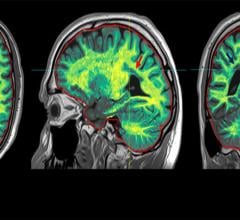March 24, 2008 - Researchers have developed a three-dimensional scanner that combines positron emission tomography (PET) and magnetic resonance imaging (MRI), in which PET spatial resolution and signal sensitivity are not compromised and MRI images are not substantially affected.
"Both modalities preserve their functionality, even when operated isochronously," the team reports in the March 24th advance online publication of Nature Medicine.
Up until now, attempts to combine the two technologies permitted only sequential data acquisition in stand-alone systems and subsequent image fusion, limiting accuracy and reproducibility. Combining PET and MRI in one system is challenging, as regular PET detectors and photomultiplier tubes are sensitive to magnetic fields.
"We are using new avalanche photodiodes (with compact silicon light sensors), which are completely based on a semiconductor structure and show therefore no interaction with the magnetic field," Bernd J. Pichler, M.D., explained in correspondence with Reuters Health.
Using mice, Dr. Pichler, at Eberhard Karls University of Tubingen in Germany, and colleagues demonstrated the complementary information that can be obtained simultaneously, such as tumor-cell proliferation and tumor necrosis and inflammation.
"The combined PET-MRI information might make histology redundant for some applications, especially for longitudinal studies of disease progression or therapy response performed in the same subject," the authors said.
They were also able to obtain PET images simultaneously with MR spectroscopic information and functional MRI data.
"I think PET/MRI is great for studies in oncology and immunology where you want to detect cells in lymph nodes or where you need good morphological information along with your PET signal," Dr. Pichler said. "Other big applications will be cardiology, where you have the advantage of simultaneous data acquisition to avoid cardiac motion artefacts, and neurology, where you can correlate different information (eg, temporal correlation of blood flow with metabolism or receptor expression)."
He noted that his team's new design for a small animal scanner is nearly ready for commercial manufacture. "We are talking with companies," he said.
"We have already a prototype human PET-MRI in Tubingen, but this is not as mature as the animal system yet," the researcher added. "It requires many more PET detectors that need to be stabilized, and we need to have all approvals for clinical applications in place. I think within the next two to three years, we will have PET/MRI scanners clinically available."
Source: Nat Med 2008 and Reuters Health
For more information: www.nature.com


 April 17, 2024
April 17, 2024 








